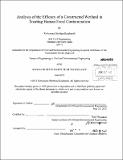Analysis of the efficacy of a constructed wetland in treating human fecal contamination
Author(s)
Kondepudi, Kathyayani Shobhna
DownloadFull printable version (9.336Mb)
Other Contributors
Massachusetts Institute of Technology. Dept. of Civil and Environmental Engineering.
Advisor
Peter Shanahan.
Terms of use
Metadata
Show full item recordAbstract
The efficiency of a system of constructed wetlands in treating non-point source pollution, particularly, human fecal contamination, was evaluated by collecting and analyzing water samples using both conventional culture-based methods to enumerate indicator bacteria and quantitative polymerase chain reaction (qPCR) method to quantify the human host-specific Bacteroides 16S rRNA genetic marker. Constructed wetlands behave as sinks and transform pollutants to improve the quality of surface runoff. The Alexandra Canal constructed wetland in Singapore is a system of four wetlands, each having different retention times, where water flows in series from a sedimentation bay to a surface flow wetland, thereafter passing through a floating aquatic wetland, and finally through a subsurface wetland. Measured concentrations of total coliform ranged between 300 and 40,000 MPN/100 mL, E. coli between 1 and 1000 MPN/100 mL, enterococci between 1 and 750 MPN/100 mL, and the HF marker between 2.7 x 10³ and 4.6 x 10 CE/100 mL. The overall removals of total coliform, E. coli, and enterococci were negligible. HF marker cells were present at higher concentrations than the indicator bacteria. The concentrations of indicator bacteria were found to decrease through the wetland system until they reached the subsurface wetland, where the concentrations increased. This may be attributed to bacterial growth in the subsurface environment in the absence of sunlight which would otherwise cause bacterial die-off. The HF marker increased as water flowed through the system; however the increase was within the range of measurement variability. No significant statistical correlations were found between microbiological indicators and the HF marker. Overall, the constructed wetland is effective in that the concentrations of indicator bacteria decreased, although further research is recommended to understand the decay mechanisms of HF marker in wetlands. Also, a better understanding of the persistence of the HF marker as compared to indicator bacteria is required.
Description
Thesis (M. Eng.)--Massachusetts Institute of Technology, Dept. of Civil and Environmental Engineering, 2012. Cataloged from PDF version of thesis. Includes bibliographical references (p. 59-63).
Date issued
2012Department
Massachusetts Institute of Technology. Department of Civil and Environmental EngineeringPublisher
Massachusetts Institute of Technology
Keywords
Civil and Environmental Engineering.